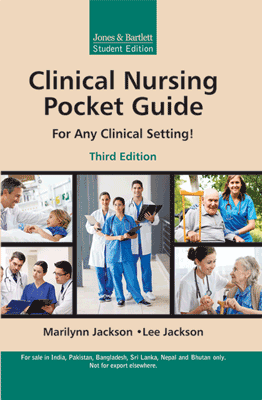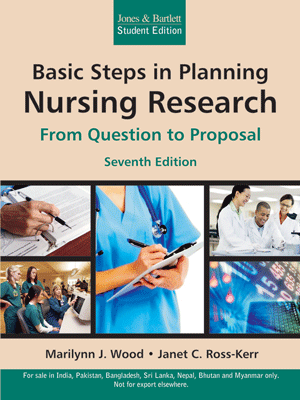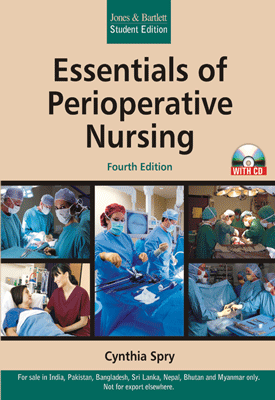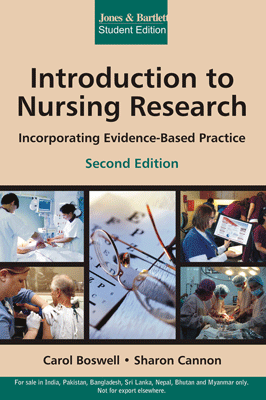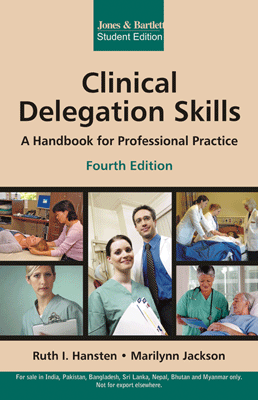Introduction to Nursing Research, 3/e
Introduction to Nursing Research, 3/e
Incorporating Evidence-Based Practice
₹895.50 ₹995.00 Save: ₹99.50 (10%)
Go to cartISBN: 9789380853901
Bind: Paperback
Year: 2015
Pages: 512
Size: 152 x 228 mm
Publisher: Jones & Bartlett Learning
Published in India by: Jones & Bartlett India
Exclusive Distributors: Viva Books
Sales Territory: India, Nepal, Pakistan, Bangladesh, Sri Lanka
Description:
Introduction to Nursing Research: Incorporating Evidence-Based Practice, Third Edition guides aspiring nurses on now to incorporate research into their future work and bring evidence based practices to the bedside. This is an essential resource nursing educators wishing to familiarize their students with tools, processes, and clinical value of nursing research and its relevance to everyday practice.
Each chapter in this Third Edition has been updated, with information on evidence, translational research, and quality improvement issues. Also featured is information on the institute of Medicine's (IOM) Future of Nursing report.
The Third Edition offers expanded chapters on:
- Overview of Evidence
- Ethics for Nursing Research and Evidence-Based Practice
- PICOT, Problem Statement, Research Question, Hypothesis
- Mixed Research Methods
- The Evidence-Based Appraisal Process
- Translational Research and Practical Applications
Target Audience:
This book is ideal for the students and academicians of Nursing.
Contents:
Preface • Acknowledgments • Contributors
Chapter 1: Connection Between Research and Evidence-Based Practice (Carol Boswell and Sharon Cannon) • Introduction • Providing a Line of Reasoning for EBP and Evidence-Based Research • Assessing the Need for Research in the Practice Arena • Obstacles to Using Research • Responsibility for Using Research • The Importance of Generating Evidence • Summary Points
Chapter 2: Overview of Evidence (Carol Boswell) • Introduction • Foundations for Evidence-Based Practice • Qualities of Evidence • Evidence Grading Methods • Conclusion • Summary Points
Chapter 3: Overview of Research (Sharon Cannon and Margaret Robinson) • Introduction • Historical Perspective • Purpose of Nursing Research • Theory, Research, and Practice • Sources for Nursing Research • Summary Points
Chapter 4: Ethics for Nursing Research and Evidence-Based Practice (Jane Sumner and Sharon Cannon) • Introduction • Ethical Theories • Historical Overview • Research Ethics • Environment for Ethical Research • Developing a Researchable Topic • Developing Researchable Questions • Participant Recruitment and Informed Consent • Data Collection and Data Analysis • Issues in Quantitative and Qualitative Research • External Pressures • Evidence-Based Practice and Ethical Implications • Publication of Research or EBP • Emerging Issues in Research and EBP • Conclusion • Summary Points
Chapter 5: PICOT, Problem Statement, Research Question, Hypothesis (Lucy B Trice and Kathaleen C Bloom) • Introduction • Determining Significance of the Problem • Examining Feasibility of the Problem • Addressing Nursing Research Priorities • Problem Statement • Research Question • Hypotheses • Defining Variables for the Study • Evidence-Based Practice Considerations • Summary Points
Chapter 6: Literature Review: Searching and Writing the Evidence (Carol Boswell and Dorothy Greene Jackson) • Introduction • Definition and Purpose of the Literature Review • The Literature Review Within the Evidence-Based Practice and/or Research Process • Differentiating a Research Article from a Nonresearch Article • Conducting a Literature Review Search • The Importance of Library Specialists in Conducting a Literature Review • The Research Idea • The Research Question • Definition of Database • Databases Useful to Nursing • Basics of Searching • Other Key Information • Evaluating the Literature • Writing the Literature Review • Summary Points
Chapter 7: Sampling (Kathaleen C Bloom and Lucy B Trice) • Introduction • Why Sample? • Whom to Sample? • How to Sample? • How Many to Sample? • Specific Evidence-Based Practice Considerations • Final Comments on Sampling • Summary Points
Chapter 8: Quantitative Research Design (Sharon Cannon) • Introduction • Characteristics of Quantitative Research Design • Descriptive Design Experimental Design • Nonexperimental Design • Time-Dimensional Design • Quasi-Experimental Design • Control • Research Design, Quality Improvement Projects, and Root Cause Analysis • Evidence-Based Considerations • Summary Points
Chapter 9: Qualitative and Mixed Research Methods (Donna Scott Tilley and JoAnn Long) • Introduction • Qualitative Research • A Brief History of Qualitative Methods • Comparing Qualitative and Quantitative Methods • Approaches to Qualitative Research • Sampling Strategies in Qualitative Research • Approaches to Qualitative Data Collection • Approaches to Qualitative Data Analysis • Methodological Rigor in Qualitative Research • Understanding and Using Qualitative Study Results • Mixed Method Research • Types of Mixed Method Strategies • Data Collection Procedures • Data Analysis and Validation Procedures • Evidence-Based Practice Considerations • Conclusion • Summary Points
Chapter 10: Data Collection (Carol Boswell) • Overview of Data Collection Methods and Sources • Accessible Data Versus Novel Data • Key Categories of Data for Nursing Studies • Significant Facets of Data Collection Schemes • Test Methods • Questionnaire Methods • Interview Methods • Focus Group Methods • Observation Methods • Secondary (Existing) Data Methods • Biophysiological Methods • Systematic Analysis • Achievement of the Data Collection Strategy • Evidence-Based Practice Considerations • Summary Points
Chapter 11: Reliability, Validity, and Trustworthiness (James Eldridge) • Introduction • Reliability as a Concept • Forms of Reliability • Validity • Conclusion • Summary Points
Chapter 12: Data Analysis (James Eldridge) • Introduction • Quantitative Analysis • Qualitative Analysis Quality Assurance • Conclusion • Summary Points
Chapter 13: The Research Critique Process and the Evidence-Based Appraisal Process (Carol Boswell and Sharon Cannon) • Rationale for Doing a Research Critique • Elements of a Research Critique • Process for Conducting a Research Critique • Critically Assessing Knowledge for Clinical Decision Making • Employing EBP Guidelines: Instruments for Holistic Practice • The Evidence-Based Appraisal • Summary Points
Chapter 14: Translational Research and Practical Applications (Carol Boswell) • Introduction • Translational Research • Logic Modeling • Action Plans • Conclusion • Summary Points
Chapter 15: Application of Evidence-Based Nursing Practice with Research (Sharon Cannon and Carol Boswell) • Introduction • Process for Evidence-Based Practice • Conclusion • Summary Points
Glossary
Index
About the Authors:
Carol Boswell, EdD, RN, CNE-ANEF, Texas Tech University Health Science Center, Texas
Dr. Boswell frequently speaks at local, state, national, and international conferences on topics ranging from health literacy, research, ethics, evidence-based practice, and leadership. She has authored multiple publications related to healthcare literacy, online teaching, research, and diabetes. Dr. Boswell has co-authored a textbook entitled Introduction to Nursing Research: Incorporating Evidence-Based Practice. She is the co-director for the Texas Tech University Health Sciences Center School of Nursing and Medical Center Hospital Center of Excellence in Evidence-Based Practice. She has been an educator for more than 15 years, working at multiple levels, including ADN, RN-BSN, graduate, and continuing education. She teaches online RN-BSN and graduate courses.
Sharon Cannon, EdD, RN-ANEF, Texas Tech University Health Science Center, Texas
Dr. Cannon is a professor and regional dean for Texas Tech University Health Sciences Center in Odessa. She has been an educator for more than 20 years in various settings, including ADN, BSN, graduate, and continuing education. She has presented at local, state, national, and international conferences with an emphasis on healthcare literacy, aging, ethics, leadership, curriculum, instruction, and online education. She has authored multiple publications on topics ranging from healthcare literacy to politics in nursing. Dr. Cannon has co-authored a textbook entitled Introduction to Nursing Research: Incorporating Evidence-Based Practice.

